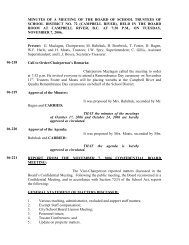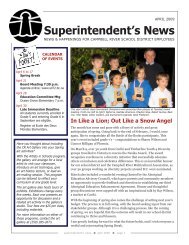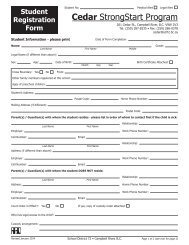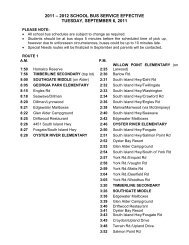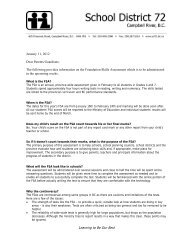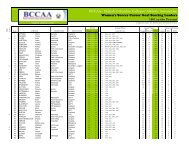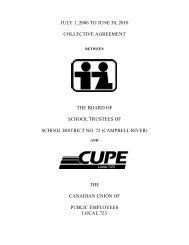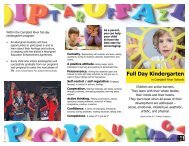2003-2004 SD72 Aboriginal Education Annual Report
2003-2004 SD72 Aboriginal Education Annual Report
2003-2004 SD72 Aboriginal Education Annual Report
- No tags were found...
You also want an ePaper? Increase the reach of your titles
YUMPU automatically turns print PDFs into web optimized ePapers that Google loves.
First Nations <strong>Annual</strong> <strong>Report</strong> <strong>2003</strong>/04 • First Nations <strong>Annual</strong><strong>Report</strong> <strong>2003</strong>/04 • First Nations <strong>Annual</strong> <strong>Report</strong> <strong>2003</strong>/04 •First Nations <strong>Annual</strong> <strong>Report</strong> <strong>2003</strong>/04 • First Nations <strong>Annual</strong><strong>Report</strong> <strong>2003</strong>/04 • First Nations <strong>Annual</strong> <strong>Report</strong> <strong>2003</strong>/04 •First Nations <strong>Annual</strong> <strong>Report</strong> <strong>2003</strong>/04 • First Nations <strong>Annual</strong><strong>Report</strong> <strong>2003</strong>/04 • First Nations <strong>Annual</strong> <strong>Report</strong> <strong>2003</strong>/04 •First Nations <strong>Annual</strong> <strong>Report</strong> <strong>2003</strong>/04 • First Nations <strong>Annual</strong><strong>Report</strong> <strong>2003</strong>/04 • First Nations <strong>Annual</strong> <strong>Report</strong> <strong>2003</strong>/04 •First Nations <strong>Annual</strong> <strong>Report</strong> <strong>2003</strong>/04 • First Nations <strong>Annual</strong><strong>Report</strong> <strong>2003</strong>/04 • First Nations <strong>Annual</strong> <strong>Report</strong> <strong>2003</strong>/04 •Submitted byStella Bates, District Vice-PrincipalFirst Nations <strong>Education</strong>School District 72Campbell River, B.C.
First Nations <strong>Annual</strong> <strong>Report</strong> <strong>2003</strong>/04Acknowledgement Page 2<strong>Aboriginal</strong> <strong>Education</strong> Enhancement Agreement Page 4Goal 1: Improving Primary Literacy Page 7Goal 2: Improving Intermediate Literacy and Numeracy Page 9Goal 3: Improving Course Participation Rates Page 17Goal 4: Decreasing Student Absenteeism Page 19Goal 5: Increasing <strong>Aboriginal</strong> Family Involvement Page 21Goal 6: Increasing Math 11 and English 12 Success Rates Page 22Goal 7: Increasing Dogwood Completion Rates Page 24Summary of <strong>2003</strong>/04 Results Page 26Summary of Local <strong>Education</strong> Improvement Results Page 27Year in Review - Student Activities Page 28School District 72 First Nations Staff Page 32Table of ContentsSchool District 72 • Campbell River, B.C.1
First Nations <strong>Annual</strong> <strong>Report</strong> <strong>2003</strong>/04AcknowledgementIt is my privilege to report on the progress being made inreducing the gap between <strong>Aboriginal</strong> and non-<strong>Aboriginal</strong>student performance in accordance with School District72’s First Nations Local <strong>Education</strong> Improvement Agreement.I respectfully submit this report to:• Campbell River First Nation• Homalco First Nation• Cape Mudge First Nations• Nuu-Chah-Nulth First Nation• North Island Metis Association• Kwakiutl District Council• Kwiakah First Nation• <strong>Aboriginal</strong> <strong>Education</strong> Advisory Council• First Nations <strong>Education</strong> Department• <strong>Aboriginal</strong> families, students and community• The Board of School Trustees, Administrators, teachers andsupport staff of School District 72Please Note:The <strong>Aboriginal</strong> <strong>Education</strong>Branch at the Ministry of<strong>Education</strong> is now referring tothe Improvement Agreementsas <strong>Aboriginal</strong> EnhancementAgreements.This is the final report on the five year Local <strong>Education</strong> ImprovementAgreement. As the Improvement Agreement concludes,School District 72, remains committed to Making ADifference for all <strong>Aboriginal</strong> students in the form of a secondfive-year Enhancement Agreement to be signed with our <strong>Aboriginal</strong>partners. This renewed agreement will build on thesuccesses of the first agreement.The School District, the First Nations <strong>Education</strong> Departmentand the current <strong>Aboriginal</strong> Advisory Council would like toacknowledge the following individuals who served as FirstNations Advisory Council members, during development of theImprovement Agreement.2School District 72 • Campbell River, B.C.
First Nations <strong>Annual</strong> <strong>Report</strong> <strong>2003</strong>/04We thank them for their wisdom and leadership in preparingthe way and setting a direction for Making A Difference in thelife chances of all <strong>Aboriginal</strong> students.• John Frishholz School District 72• Freda McLeanKlahoose First Nation• Allison Trenholm Homalco First Nation• Nancy Henderson Campbell River First Nation• Lawrence Lewis Cape Mudge First NationDuring the <strong>2004</strong>-2005 school year the current Advisory Councilhas focussed on:• Open and positive communication among all of the partnersin <strong>Aboriginal</strong> <strong>Education</strong>.• <strong>Aboriginal</strong> resources in schools and school curriculum, includingLiqwala/Kwakwala and Coast Salish languages, andawareness of the Metis culture and Michaf language.• District’s progress in reducing the gap between <strong>Aboriginal</strong>and non-<strong>Aboriginal</strong> performance on local and provincialassessments.• The renewed Enhancement Agreement.This report is dedicated toEva Dingwall and DianaMatilpi for all their years ofservice at School District 72.School District 72 • Campbell River, B.C.3
First Nations <strong>Annual</strong> <strong>Report</strong> <strong>2003</strong>/04Building Success — Goals for <strong>Aboriginal</strong> Students1. Year by year improvement in <strong>Aboriginal</strong> student achievementin literacy and numeracy at the intermediate andmiddle school levels. (Grades 4-9)Rationale for the Goal:The need to improve the performance levels for our <strong>Aboriginal</strong>students at the intermediate and middle schoollevels is critical. Extra efforts must be made to ensurethat personal, cultural and academic success is promotedthrough relevant, engaging and systematic strategies thatpromote successful learning at this challenging stage ofdevelopment.Without continued academic and social progress in theintermediate and middle school grades, a graduationprogram can become out of reach, thus closing manydoors to future opportunities.2. Year by year improvement in the rates of <strong>Aboriginal</strong> studentswho graduate with a Dogwood Certificate.Rationale for the Goal:Graduation rates improved throughout the first Agreementbut results were inconsistent and so the goal mustbe maintained. Ministry data shows that an importantfactor in graduation rates is the number of students successfullymaking the year-by-year transition from gradeto grade. The greatest rate of drop off in transition rateshappens at the secondary level.Data, collected locally, shows that there is a greater patternof relocation for <strong>Aboriginal</strong> students, often due toeconomic, family and/or cultural reasons. The secondAgreement will focus on transition rates as a means ofimproving graduation rates for <strong>Aboriginal</strong> students.Mother, Child and the Moonby Stacia Goodman,Carihi Secondary studentTransitions present special challenges for <strong>Aboriginal</strong>students throughout their school careers, which becomeincreasingly more difficult at the middle and secondarylevels. It is often during these times of change, fromgrade-to-grade, school-to-school, district-to-district orlevel-to-level that <strong>Aboriginal</strong> students lose momentum intheir social, cultural and academic development.School District 72 • Campbell River, B.C.5
First Nations <strong>Annual</strong> <strong>Report</strong> <strong>2003</strong>/043. To increase the number of <strong>Aboriginal</strong> students who graduatehaving met post-secondary requirements aligned topersonal career goals.Rationale for the Goal:Too many <strong>Aboriginal</strong> students graduate without a suitablerange of post-secondary entrance requirements, andare frequently returning to school after graduation to“upgrade” to meet these requirements. Course selectionand relevant skill development need to go hand in handfor <strong>Aboriginal</strong> students in order that their graduationprograms reflect their skills, knowledge, passions andfuture goals.All too often a graduation program for an <strong>Aboriginal</strong>student includes Communications and Essentials Mathin combination with a limited science and socials studiesbackground. <strong>Aboriginal</strong> students are often unawareof the wide range of post-secondary and career optionsavailable to them.The new graduation program in combination with the renewedenhancement agreement, presents an opportunityto ensure that <strong>Aboriginal</strong> students are being targeted,supported and encouraged to include appropriate postsecondaryprerequisites in their graduation programs.4. Increase a positive sense of identity and self-acknowledgementfor <strong>Aboriginal</strong> students.Rationale for the Goal:A positive sense of self-identity and self-acknowledgementare critical for <strong>Aboriginal</strong> students to experienceacademic and social success. <strong>Aboriginal</strong> students needgreater access to learning opportunities that allow themto feel connected, capable and responsible and whichsupport them in developing positive attitudes, attendanceand achievement.6School District 72 • Campbell River, B.C.
First Nations <strong>Annual</strong> <strong>Report</strong> <strong>2003</strong>/04Local <strong>Education</strong> ImprovementAgreement ResultsComparison of Gap1998/99 to <strong>2003</strong>/04ActualGap98/99 9%DesiredGapTarget99/00 -1% 8.82% Met00/01 0% 8.64% Met01/02 3% 8.46% Met02/03 0% 8.28% Met03/04 1% 8.10% MetRationale for goal:Reading competency is one of the strongest indicators ofschool success. A solid foundation in early literacy is criticalin making a difference for First Nation students. Researchshows that at least 1,500 hours of interaction with print materialbefore entering Grade 1 contributes significantly to readingreadiness. Therefore, efforts to ensure that this occurs arein place both in the school system and in the <strong>Aboriginal</strong> HeadStart and pre-school programs.District progress in reducing the gap:• Target MetThere continues to be a great deal of success in improving primaryliteracy for First Nations students. The <strong>2003</strong>/<strong>2004</strong> Grade3 District Reading Assessment demonstrated no significant differencebetween First Nations and non-First Nations studentsclassified as not within expectations. Altogether, 403 studentswere tested and 60 were First Nations. The following comparisonshows how First Nations and non-First Nations studentsperformed in all categories measured on the assessment.Grade 3 District Reading Assessment:“Not Yet Within Expectations”Goal 1: Improving Primary LiteracySchool District 72 • Campbell River, B.C.7
First Nations <strong>Annual</strong> <strong>Report</strong> <strong>2003</strong>/04How we are making a difference:• Partnerships with <strong>Aboriginal</strong> Head Start programs.• Full day kindergartens on reserves.• Systematic assessment and intervention for at-riskreaders.• First Nations content, language and culture programsand activities.• Local development of First Nations curriculum materials.• Breakfast/lunch programs.• First Nations Support Worker and First Nations <strong>Education</strong>Assistant support.• Parental and First Nations Advisory Council involvement.• Developing renewed Enhancement Agreement with<strong>Aboriginal</strong> Advisory Council.• School-wide literacy assessments to inform instruction.• Development of school-based <strong>Aboriginal</strong> <strong>Education</strong> ActionPlan.• Inclusion of <strong>Aboriginal</strong> goals in School Growth Plansand District Accountability Contract.8School District 72 • Campbell River, B.C.
First Nations <strong>Annual</strong> <strong>Report</strong> <strong>2003</strong>/04Rationale for goal:Literacy and numeracy continue to be critical skills at the intermediatelevel, and are the necessary foundations for successfulsecondary school experience.Province-wide Grade 4 Foundation Skills Assessment results in1998/99 demonstrated a significant gap between First Nationsand non-First Nations students meeting or exceeding expectationsin reading, first-draft writing and numeracy.District progress in reducing the gap:• Grade 4 FSA Reading Results:Target Not Met• Grade 4 FSA Writing Results:Target Met• Grade 4 FSA Numeracy Results:Target MetProvincial skills assessments in <strong>2003</strong>/04 revealed that we hadnot met our targets of reducing the gap between First Nations andnon-First Nations student performance in Grade 4 Reading forthe third year in a row.The target was set at a 20.70% gap but the actual results were24%. However, we were closer to reaching our target this year. Incontrast, we met our targets in both Grade 4 Writing and Grade 4Numeracy.The following comparison shows how First Nations and non-FirstNations Grade 4 students performed in all categories measuredon the assessment:Goal 2: Improving Intermediate Literacy & NumeracySchool District 72 • Campbell River, B.C.9
First Nations <strong>Annual</strong> <strong>Report</strong> <strong>2003</strong>/04Grade 4 FSA Reading Results:“Meets and Exceeds Expectations”Comparison of Gap1998/99 to <strong>2003</strong>/04ActualGap98/99 23%DesiredGapTarget99/00 20% 22.54% Met00/01 21% 22.08% Met01/02 31% 21.62% Not Met02/03 27% 21.16% Not Met03/04 24% 20.70% Not MetGrade 4 FSA Writing Results:“Meets and Exceeds Expectations”Comparison of Gap1998/99 to <strong>2003</strong>/04ActualGap98/99 11%DesiredGapTarget99/00 1% 10.78% Met00/01 3% 10.56% Met01/02 8% 10.34% Met02/03 10% 10.12% Met03/04 7% 9.9% MetFN Grade 4 Reading10School District 72 • Campbell River, B.C.
First Nations <strong>Annual</strong> <strong>Report</strong> <strong>2003</strong>/04Grade 4 FSA Numeracy Results:“Meets and Exceeds Expectations”Comparison of Gap1998/99 to <strong>2003</strong>/04ActualGap98/99 16%DesiredGapTarget99/00 16% 15.68% Not Met00/01 12% 15.36% Met01/02 17% 15.04% Not Met02/03 14.5% 14.72% Met03/04 6% 14.40% MetFN Grade 4NumeracySchool District 72 • Campbell River, B.C.11
First Nations <strong>Annual</strong> <strong>Report</strong> <strong>2003</strong>/04Grade 6 District Reading Assessment:This is the fifth year in a row that we have successfully met thetarget to reduce the gap between the number of First Nations andnon-First Nations students who fully meet and exceed expectationsin the Grade 6 District Reading Assessment.District progress in reducing the gap:• Target MetThis year the gap was 12% and the goal was 35.10%, putting us23.10% ahead of target.Grade 6 District Reading Assessment:“Fully Meets and Exceeds Expectations”Comparison of Gap1998/99 to <strong>2003</strong>/04ActualGap98/99 39%DesiredGapTarget99/00 38% 38.22% Met00/01 11% 37.44% Met01/02 9% 36.66% Met02/03 19% 35.88% Met03/04 12% 35.10% Met12School District 72 • Campbell River, B.C.
First Nations <strong>Annual</strong> <strong>Report</strong> <strong>2003</strong>/04Grade 7 Foundation Skills Assessment:In the year that the targets were set for Grade 7 Reading, there wasa particularly small gap in performance levels between First Nationsand non-First Nations students who meet and exceed expectations.Each year since, the gap has increased. But in <strong>2003</strong>/04, the gap wasreduced from 26 per cent to 20 per cent.Fortunately this is only true for Grade 7 Reading results and the targetswere met for both Writing and Numeracy.District progress in reducing the gap:• Grade 7 FSA Reading Results:Target Not Met• Grade 7 FSA Writing Results:Target Met• Grade 7 FSA Numeracy Results:Target MetSchool District 72 • Campbell River, B.C.13
First Nations <strong>Annual</strong> <strong>Report</strong> <strong>2003</strong>/04Grade 7 FSA Numeracy Results:“Meets and Exceeds Expectations”Comparison of Gap1998/99 to <strong>2003</strong>/04ActualGap98/99 16%DesiredGapTarget99/00 22% 15.68% Not Met00/01 25% 15.36% Not Met01/02 22% 15.04% Not Met02/03 6% 14.72% Met03/04 7% 14.40% MetFN Grade 7NumeracySchool District 72 • Campbell River, B.C.15
First Nations <strong>Annual</strong> <strong>Report</strong> <strong>2003</strong>/04Grade 9 District Reading Assessment:For the third year running we have met the targets for reducingthe gap in First Nations and non-First Nations student performancein the number of students who fully meet or exceed expectationson the Grade 9 District Reading Assessment.District progress in reducing the gap:• Target MetGrade 9 District Reading Assessment:“Fully Meets and Exceeds Expectations”Comparison of Gap1998/99 to <strong>2003</strong>/04ActualGap98/99 25%DesiredGapTarget99/00 17% 24.5% Met00/01 30% 24% Not Met01/02 9% 23.5% Met02/03 10% 23% Met03/04 16% 22.5% Met16School District 72 • Campbell River, B.C.
First Nations <strong>Annual</strong> <strong>Report</strong> <strong>2003</strong>/04Rationale for goal:An important part of our <strong>Education</strong>al Agreement is to honour andsupport the histories, cultures and languages of the First Nationswhose traditional territories are served by School District 72.District progress in reducing the gap:• Target Not MetA participation rate target of 75% for First Nation students wasset in 1998/99. At the end of 2000/01, the proportion of FirstNations students earning a minimum of four credits towardgraduation in First Nations courses was 61%. In 2001/02, theparticipation rate was down to 41%. However, the gap goal was39.48% and the actual gap was only 34%. In 2002/<strong>2003</strong>, we sawa 36% participation rate, leading to a gap of 39%. In <strong>2003</strong>/04, theparticipation rate was 34.5%, with a gap of 40.5%. The gap goalwas 37.8%How we are making a difference:• Kwakwala/Liq’wala instruction for over 20 years.• Knowledgeable and skilled speakers as teachers and LocalLanguage Authorities.• Locally developed language curriculum and teachingmaterials.• Kwakwala/Liq’wala offered at Campbellton, Quadra,Cedar, Ecole Phoenix and Carihi.• Coast Salish curriculum materials being developed andtaught at Georgia Park.• Language Authorities established through College ofTeachers for Klahoose and Holmalco Bands.• Partnered with University of Victoria to have CampbellRiver based teacher training program for DevelopmentalStandard Certification in Coast Salish and Kwakwala/Liq’wala(program ladders to University of VictoriaBachelor of <strong>Education</strong> Elementary).• University of Victoria recognizes Kwakwala/Liq’wala asfulfilling the entrance requirement for a second language.Goal 3: Improving Course Participation RatesSchool District 72 • Campbell River, B.C.17
First Nations <strong>Annual</strong> <strong>Report</strong> <strong>2003</strong>/04Participation Rates:in First Nations CoursesEcole GeorgiaElementary Field Trip18School District 72 • Campbell River, B.C.
First Nations <strong>Annual</strong> <strong>Report</strong> <strong>2003</strong>/04Rationale for goal:Poor attendance contributes greatly to a lack of success at allgrade levels. Skill and curriculum development is based on steadyincremental steps and with frequent absences it becomes impossibleto keep up within a classroom setting.District progress in meeting the goal:• Target MetIn 1998/99, a gap of 38% was established given a goal of 90% anda baseline of 52%. Since then the gap has been 33%, 40%, 40%and 31%. This year the composite rate of students having fewerthan 15 absences from the elementary, middle and secondarylevels was 63.5%, for a gap of 26.5%.How we are making a difference:• School-based action plans have identified improvingattendance as a goal in their First Nations <strong>Education</strong>action plans.• Support and contact with First Nations Youth Workers.• Communication between schools andfamilies.• Elementary and middle school progress is consistentlybetter.• First Nations Youth Workers and schools are developingstrategies for improving/rewarding attendance.Goal 4: Decreasing Student AbsenteeismSchool District 72 • Campbell River, B.C.19
First Nations <strong>Annual</strong> <strong>Report</strong> <strong>2003</strong>/04<strong>Aboriginal</strong> Attendance:1998/99 - <strong>2003</strong>/0420School District 72 • Campbell River, B.C.
First Nations <strong>Annual</strong> <strong>Report</strong> <strong>2003</strong>/04Goal 6: Increasing Math 11 & English 12 Success RatesComparison of Gap1998/99 to <strong>2003</strong>/04ActualGap98/99 22%DesiredGapTarget99/00 38% 21.56% Not Met00/01 37% 21.12% Not Met01/02 37% 20.68% Not Met02/03 32% 20.24% Not Met03/04 46% 19.80% Not MetRationale for the Goal:Increase the participation and success rates in Principles of Mathematics11 and English 12 courses, in order to broaden the rangeof post-secondary program options for First Nations students.District progress in meeting the goal:• Principles of Math 11Target Not Met• English 12 ResultsTarget MetIn <strong>2003</strong>/<strong>2004</strong>, 9 First Nations and 210 non-First Nations studentstook Principles of Math 11. Seven of the First Nationsstudents completed the course successfully at a rate of 78%. Thenon-First Nations students were successful at a rate of 87%.In <strong>2003</strong>/<strong>2004</strong> 37% of First Nations Grade 12s participated inEnglish 12, with a success rate of 100%. At the same time, theirnon-First Nations peers had a 71% participation rate with 100%of them scoring C- and above.Principles of Math 11: Participation Rates22School District 72 • Campbell River, B.C.
First Nations <strong>Annual</strong> <strong>Report</strong> <strong>2003</strong>/04Grade 12 English Participation Rates:Comparison of Gap1998/99 to <strong>2003</strong>/04ActualGap98/99 43%DesiredGapTarget99/00 39% 42.14% Met00/01 40% 41.28% Met01/02 45% 40.42% Not Met02/03 28% 39.56% Met03/04 19% 38.70% MetFNHow we areGrademaking a difference:12assessment data for these courses.English• First Nations study/support rooms exist to provide students• Carihi and Timberline Secondary schools now have a writtenaction plan for First Nations students that includes goals andwith a home base in the school.• Alternate methods of delivering math curriculum are being investigatedat the district and school levels.• English Skills Development is offered at Carihi to support successin regular English courses, utilizing leadership skills topromote relevancy, with instruction based on individual studentassessments.• School-based late literacy committees have participated in lateliteracy professional development activities.• Literacy and English 12 preparation.School District 72 • Campbell River, B.C.23
First Nations <strong>Annual</strong> <strong>Report</strong> <strong>2003</strong>/04Graduation Rates:“Dogwood Completion”Comparison of Gap1998/99 to <strong>2003</strong>/04ActualGap98/99 27%DesiredGapTarget99/00 32% 26.46% Not Met00/01 39% 25.92% Not Met01/02 30% 25.38% Not Met02/03 47% 24.84% Not Met03/04 23% 24.30% MetSchool District 72 • Campbell River, B.C.25
First Nations <strong>Annual</strong> <strong>Report</strong> <strong>2003</strong>/04Summary of <strong>2003</strong>/04 Results• Primary Literacy• Grade 4 Reading• Grade 4 Writing• Grade 4 Numeracy• Grade 6 District Assessment• Grade 7 Reading• Grade 7 Writing• Grade 7 Numeracy• Grade 9 District Assessment• First Nations Courses Participation Rates• Student Absenteeism• First Nations Parents Involvement• Math 11• English 12• Dogwood Completion RateTarget MetTarget Not MetTarget MetTarget MetTarget MetTarget Not MetTarget MetTarget MetTarget MetTarget Not MetTarget MetTarget MetTarget Not MetTarget MetTarget Met26School District 72 • Campbell River, B.C.
First Nations <strong>Annual</strong> <strong>Report</strong> <strong>2003</strong>/04As educators, parents, elders, communitymembers, we should all be proudof our collective efforts to improve theeducational outcomes of First Nations students.The Local <strong>Education</strong> Improvement Agreement— one of the first in the province — hasguided the district in obtaining better results,and at the same time, it has taught us somevaluable lessons about making a difference forour First Nations learners.We know that First Nations students learnbest when schools:• continue to build trust with parents, communityand students.• acknowledge that connecting with the FirstNations communities is fundamental to understandingthe hopes and desires that FirstNations families have for their children.• establish and develop cultural relevanceand positive self-concept in its curriculum— something that is one of the strongestpredictors of school success.• find ways to tap into intrinsic motivationand respectful humor to motivate.• encourage and help to establish family supportfor First Nations students.• work together with First Nations families toprovide and value situations that yield smallsuccesses and positive feedback for students• make personal connections with First Nationsstudents.• have classroom practices that are highly engagingand use activity-based learning.• show a commitment to providing First Nationsrole models in the schools.• establish and teach flexible, fair, and consistentapproaches to promoting effectivebehavior.• provide real audience and purpose for studentwork that builds relevancy such as theFirst Nations Leadership and Media programs.Change is not always easy, but I believe thatfuture challenges can be met if we base ourdecisions on data, research and best practices.This is why the First Nations Advisory Councilhas developed an Enhancement Agreementwith previous lessons in mind, along with ananalysis of what works in other jurisdictions.Regardless of the new targets established inthe renewed agreement, it must be rememberedthat our overall goal as an educationalcommunity must always be equality ofopportunity and results for First Nationslearners.Summary of Local <strong>Education</strong> Improvement ResultsSchool District 72 • Campbell River, B.C. 27
First Nations <strong>Annual</strong> <strong>Report</strong> <strong>2003</strong>/04Year in Review - Student ActivitiesCampbelltonElementary School• Buddy Reading with CarihiFN Leadership students• Kwakwala/Liq’wala CarihiStudent Helpers• Grade 6 Roy Henry VickersArt Project• Log Carving with JuniorHenderson• Carving Shed visits courtesy ofBill Henderson• Kwakwala/Liq’wala Program• Afternoon Kindergarten• Student Recognition Assemblies• First Nations Youth SupportWorker & <strong>Education</strong>al Assistant• Justice Theatre Workshop• <strong>Aboriginal</strong> Youth Orchestra• On-reserve Interviews for<strong>Report</strong> Cards• Monthly Parent-Club Meetingswith Principals• Celebrate <strong>Aboriginal</strong> Day• Ready, Set, LearnCedarElementary School• Cultural program• Multicultural Day & National<strong>Aboriginal</strong> Day Celebration• Culture & History Project• Breakfast and Lunch Program• Afternoon Kindergarten Program• First Nations Youth SupportWorker & <strong>Education</strong>al Assistants• Attendance RecognitionAwards• Principal’s Tea• Virtues/Calendar Celebration• Homework Club• ESD Program• Peer Tutoring• School-Wide Luncheon• Kwakwala/Liq’wala LanguageProgram• Kyuquot Luncheon• Rainbows Program• Literacy Open House• Ready, Set, Learn• Christmas Concert• Monthly Recognition Assemblies28School District 72 • Campbell River, B.C.
First Nations <strong>Annual</strong> <strong>Report</strong> <strong>2003</strong>/04École Georgia ParkElementary• First Nations Artist• Ready, Set, Learn• National Youth Orchestra– Courtenay• ESD Program• First Nations Support Worker& <strong>Education</strong>al AssistantHomalco Youth ServicesWorker’s Activities• Traditional Parenting• Homework Club• Continuing <strong>Education</strong>PinecrestElementary School• Cultural Field Trip• First Nations Celebration• ESD Program• First Nations Youth SupportWorker• Peer Tutors• Friends Program• Christmas Concert• Lunch Program• Monthly Recognition• Legend and Myth Study ofFirst Nations• Ready, Set, LearnSandowneElementary School• First Nations Celebration Day• ESD Program• First Nations Youth SupportWorker• Ready, Set, Learn• Justice Theatre• Museum/Carving Shed visits• Drum WorkshopQuadraElementary School• Rebecca Spit day• Kwakwala/Liq’wala program.• Power Speak Program.• Summer 2002 literacy program.• First Nations Youth SupportWorker and <strong>Education</strong>al Assistant.School District 72 • Campbell River, B.C. 29
First Nations <strong>Annual</strong> <strong>Report</strong> <strong>2003</strong>/04School District 72 First Nations StaffFirst Nations Youth Support Workers’ Vision• First Nations parents who feel comfortable visiting schools tosee classes, their children, teachers, counsellors and administrators.• First Nations students who enter Grade 10 with good solid literacyand numeracy skills.• First Nations students who have the skills to take the responsibilityto be in class on time.• First Nations students who live in healthy home environments.• First Nations students who carry a regular course load thatmeets a range of post-secondary requirements.• First Nations graduation rates that match those of non-First Nationsstudents.• Evidence of First Nations culture throughout the school buildings.• First Nations Support Workers working as a team toward a commonvision.Goals for <strong>2004</strong>/2005• Improve attendance of First Nations students.• Improve transitions for First Nations students.• Promote healthy living for First Nations students.• Develop cultural awareness in the education community andpride for First Nations students.32School District 72 • Campbell River, B.C.
First Nations <strong>Annual</strong> <strong>Report</strong> <strong>2003</strong>/04First Nations YouthSupport Workers• Mel Roberts• Roberta Henderson• Gena Sanderson• Kathy Thibeault• Joedy Williams• Freda MacLean• Jacquie ToombsFirst Nations KindergartenTeachers• Kathy YowHomalco Kindergarten• Kaz JonesGengenlilas Kindergarten& Cape Mudge Head Start• Linda SpoonerLaichwiltach KindergartenESD Teachers• Don PennellCampbellton Elementary• Doranne DeMontignyCampbellton• Tom KennedyCedar Elementary• Lisa JohnsonÉcole Georgia ParkElementary• Colleen EppPinecrest Elementary• Anne HowarthSandowne Elementary• Jane MonchakEcole Phoenix Middle School• Kathy GrantCarihi SecondaryFirst Nations LanguageTeachers• Pam Holloway• Sheryl Thompson• Patti James• Marian Harry• Dene LaFleur(Local Language Authority/Elder Advisor)<strong>Education</strong>al Assistants• Edwina HendersonCampbellton Elementary• Charity PerraultCedar Elementary• Violet PerraultCedar Elementary• Elizabeth PetahtagooseÉcole Georgia ParkElementary• Brenda AssuQuadra Elementary• Darlene GuentherSouthgate Middle School• Jodi GuyCarihi SecondaryFirst Nations Support/Program Teachers• Kathy GrantCarihi Secondary• Steve JoyceTimberline Secondary• Trevor McMonagleCarihi Secondary• Lisa JohnsonSouthgate Middle School• Natalie HandyTimberline Secondary• Jane MonchakÉcole Phoenix Middle School• Bridget WalshQuadra ElementarySchool District 72 • Campbell River, B.C. 33



